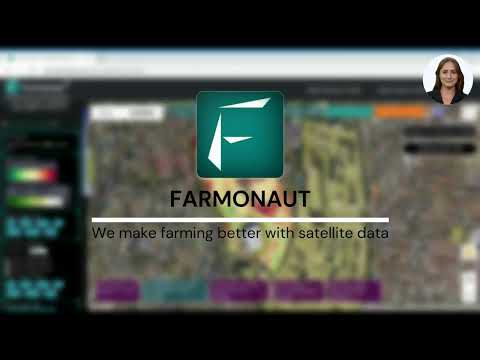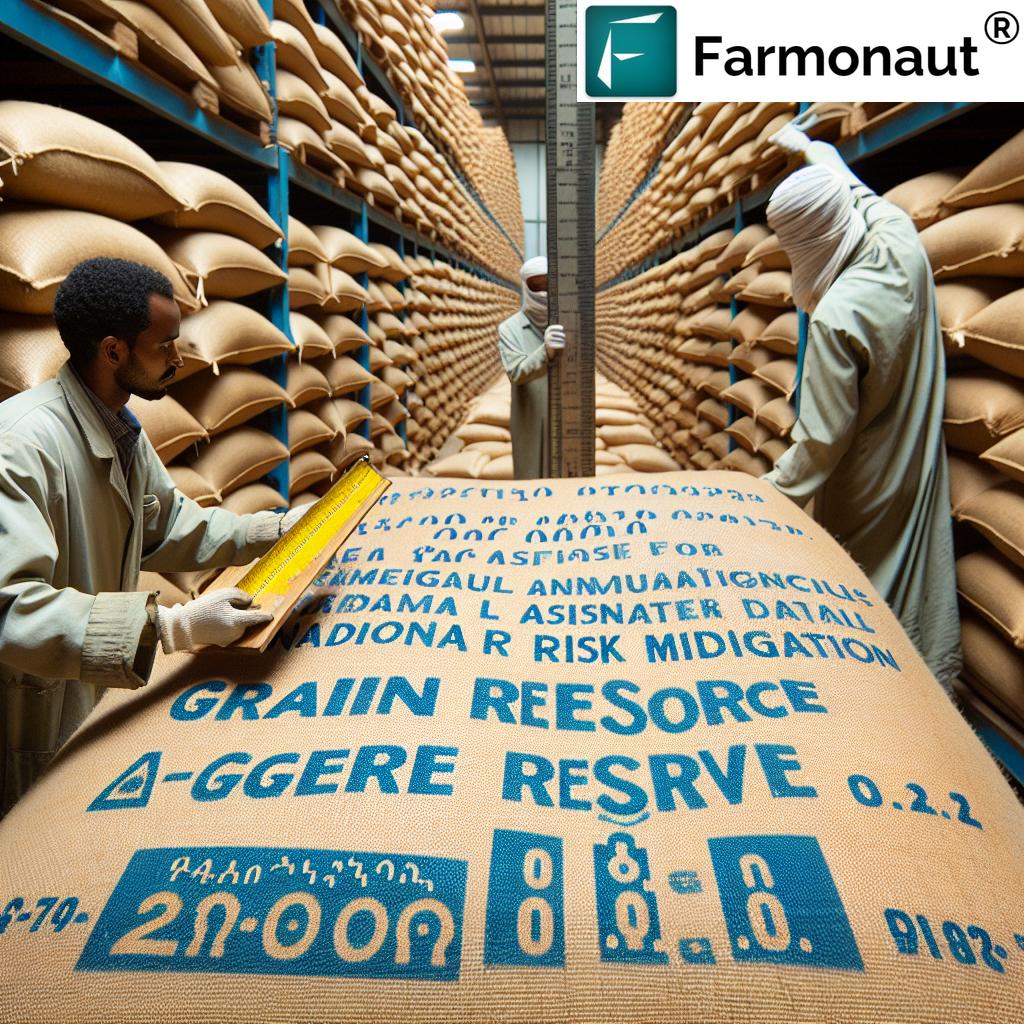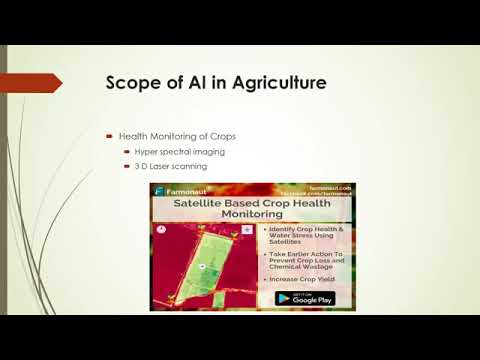7 Key Strategies for Food Sovereignty and Security in Ethiopia
Date: Addis Ababa, April 26, 2025
Table of Contents
- Introduction: Food Sovereignty in Ethiopia
- Strategy 1: Enhancing Strategic Grain Reserves
- Strategy 2: Advancing Disaster Risk Management Ethiopia
- Strategy 3: Cluster Farming Initiatives for Increased Productivity
- Strategy 4: Scaling Fruit and Vegetable Cultivation Ethiopia
- Strategy 5: Strengthening Humanitarian Assistance Mechanisms
- Strategy 6: Empowering Supply Chain Ethiopia Through Technology
- Strategy 7: Building National Food Security Preparedness
- Comparative Strategy Impact Table
- Farmonaut’s Role in Sustainable Agricultural Development
- Frequently Asked Questions (FAQ)
- Conclusion
Introduction: Food Sovereignty in Ethiopia—A Foundation for Security
Food sovereignty in Ethiopia is far more than an agricultural aspiration; it is a cornerstone of our nation’s security, social cohesion, and sustainable prosperity. Our ability to produce, distribute, and consume food according to our needs—not subject to undue external influence—embodies sovereignty and self-determination. As highlighted by National Disaster Risk Management (NDRMC) Commissioner Shiferaw Teklemariam during an exclusive interview in Addis Ababa, April 2025, food sovereignty is the essential pillar supporting national disaster risk management, grain reserve management, and Ethiopia’s bold agricultural development strategies.
Why is food sovereignty in Ethiopia so vital? In our context, ensuring food sovereignty secures not only the wellbeing of millions, but also the dignity, resilience, and independence of our nation. It equips us to proactively mitigate disaster-related risks, fosters preparedness for food deficits, and empowers Ethiopia to shape its own food production, distribution, and consumption patterns.
In this comprehensive guide, we will explore the 7 key strategies for food sovereignty and security in Ethiopia—each addressing current challenges and driving us toward a sustainable, self-reliant future backed by robust management systems, technological innovation, and community-focused initiatives.
Strategy 1: Enhancing Strategic Grain Reserves
Grain Reserve Management: A National Security Pillar
One of the most critical elements for food sovereignty in Ethiopia is the institution and management of strategic grain reserves. With the nation producing approximately 600 million quintals of grain annually, establishing and maintaining a robust grain reserve is indispensable for ensuring emergency preparedness and humanitarian responses during periods of deficit or disaster.
- National Target: Maintain a reserve of 2 million metric tons to address emergencies and supply disruptions.
- Progress: Regions have already secured around 1 million quintals, which is 40% of the reserve needed for full national preparedness.
Why does grain reserve management matter? These reserves are a direct buffer against unpredictable hazards—whether drought, conflict, or market shock. They strengthen national food security, serving as a safety net for affected populations and reducing reliance on external food assistance.
The strategic placement of warehouses at the regional and woreda levels, as championed by NDRMC, further decentralizes grain storage—enabling faster, locally responsive action when hazards strike.
It’s important to ensure strict supply chain Ethiopia protocols and storage technologies, supported by periodic audits and up-to-date monitoring systems, for optimal food quality maintenance.
Strategy 2: Advancing Disaster Risk Management Ethiopia
Proactive Mitigation Against Hazards
Robust disaster risk management Ethiopia mechanisms form the backbone of food security and sovereignty. Rather than reacting post-crisis, our focus must be on proactive risk assessment, reduction, and resilience building to hazards like droughts, floods, earthquakes, and locust invasions.
Core components include:
- Comprehensive hazard risk mapping and vulnerable region identification
- Community-based early warning systems
- Integrated rapid response protocols linking regional and national agencies
- Investment in preparedness workshops and simulation exercises
- Enhanced storage and logistical assets for rapid deployment of food and resources
According to NDRMC Commissioner Shiferaw Teklemariam, nine regions now demonstrate complete self-reliance in managing localized disasters, having established their dedicated response funds and protocols. The role of scientific data, including satellite imagery and AI-based predictive models, further supports disaster risk forecasting and response, ensuring food sovereignty in Ethiopia even under duress.
Strategy 3: Cluster Farming Initiatives for Increased Productivity
Cluster Farming: Boosting Yields and Sovereignty
Cluster farming initiatives—central to the ‘Bounty of the Basket’ national initiative—are transforming the agricultural landscape in Ethiopia. By organizing farmers into clusters, we optimize resource allocation, standardize crop production, and efficiently channel government support to maximize output and minimize risk.
Advantages of cluster farming initiatives:
- Facilitates mechanization and modern input usage
- Improves access to extension services and climate-smart technologies
- Strengthens community cooperation for coordinated harvesting and storage
- Enables consistent distribution and consumption patterns at both local and national levels
Cluster farming is instrumental in reaching Ethiopia’s grain production targets and expanding the capacity for surplus. With coordinated implementation, we create an environment where post-harvest loss is minimized, and supply chain Ethiopia systems become more predictable and resilient.
Strategy 4: Scaling Fruit and Vegetable Cultivation Ethiopia
Diversifying Diets, Expanding Opportunity
While grains remain Ethiopia’s primary staple, scaling fruit and vegetable cultivation Ethiopia is key for balanced nutrition, improved health, and economic diversification. The government’s increased investment in horticulture supports year-round harvesting, surplus production, and export possibilities, reducing overreliance on single crops and mitigating potential food security risks.
- Integrating advanced irrigation and precision farming techniques
- Encouraging household- and community-based fruit and vegetable gardens
- Supporting value chain development for processing, storage, and market access
The integration of sustainable practices with digital advisory support systems ensures that both large- and small-scale producers can maximize yields—improving national diets and creating additional food reserves in the event of shocks or disasters. Farmonaut’s crop plantation and advisory tools are ideal for orchard and garden monitoring, providing satellite-driven insights into crop health, irrigation needs, and harvest timing for optimal vegetable and fruit output.
Strategy 5: Strengthening Humanitarian Assistance Mechanisms
Humanitarian Support Sovereignty
Securing food sovereignty in Ethiopia extends beyond agricultural productivity to establishing robust humanitarian assistance mechanisms. We must be prepared for both surplus and deficit, with systems that guarantee rapid, dignified support to affected populations during times of crisis.
Key elements of humanitarian support sovereignty include:
- Decentralized emergency food storage facilities (regional and woreda warehouses)
- Integrated population vulnerability monitoring
- Pre-positioned logistics for disaster response
- Transparent, data-driven decision making for aid distribution
As Ethiopia advances towards a reserve of 2 million metric tons of grain, emphasis on mechanisms that maintain supply chain integrity and transparency is critical. Farmonaut’s blockchain-based traceability platform can further strengthen food supply chain Ethiopia operations, offering real-time, secure tracking to ensure that humanitarian food reaches those who need it most efficiently and without corruption.
Strategy 6: Empowering Supply Chain Ethiopia Through Technology
Harnessing Digital Transformation For Food Security
The modernization and digitalization of food supply chain Ethiopia networks represent a transformative strategy for national food security and sovereignty. Modern technologies address prevalent challenges like post-harvest losses, inefficiencies in distribution, and a lack of real-time data on stock, transport, and consumption patterns.
Technological solutions play critical roles:
- Fleet management tools: Optimize food delivery logistics and vehicle usage, cut down operational costs, and ensure timely humanitarian and commercial grain dispatch.
- Satellite-based crop health monitoring and analytics: Real-time assessment of agricultural zones for informed harvesting, storage, and market supply decisions.
- Blockchain traceability systems: Guarantee security and transparency in grain movement, strengthening resilience to fraud and external influence over our food supply chain Ethiopia.
- API integrations: Developers and agricultural organizations can connect directly to Farmonaut’s satellite weather and field data API and developer documentation for custom tools, dashboards, or policy planning software.
By leveraging these advanced capabilities, we can maintain sovereignty over our food supply, minimize wastage, and ensure sustainability from farm to fork.
Learn how Farmonaut’s large-scale farm management system empowers agribusinesses, cooperatives, and government bodies to oversee thousands of hectares—strengthening food sovereignty in Ethiopia efficiently and cost-effectively.
Strategy 7: Building National Food Security Preparedness
Beyond Recovery: Achieving Resilience and Surplus
By embedding a culture of preparedness, we equip Ethiopia to not only weather food crises but also utilize years of surplus strategically for development. National food security preparedness integrates all previous strategies by fostering coordination among:
- The government and regional administrations for harmonized grain reserve management
- Active risk communication to ensure farmers and supply chain actors are always informed of hazards
- Continual training to enable communities and disaster responders to act autonomously
- Regular stocktaking and technological upgrades in all warehouses and collection centers
Preparedness means building reserves during the harvest season, implementing adaptive responses during disaster, and promoting sustainable distribution and consumption patterns that keep Ethiopia self-sufficient. Crucially, we must ensure that national security policies explicitly incorporate food sovereignty as a pillar of independence and resilience to external stressors.
Comparative Strategy Impact Table
| Strategy | Description | Estimated Impact on Food Sovereignty | Estimated National Security Benefit | Disaster Risk Management Relevance | Estimated Implementation Timeline (Years) |
|---|---|---|---|---|---|
| Enhancing Strategic Grain Reserves | Establish and maintain decentralized reserves to buffer shocks, ensuring supply during crises | High | High | Yes | 1-3 |
| Advancing Disaster Risk Management Ethiopia | Proactive, regionally tailored risk assessment and response to natural and man-made hazards | High | High | Yes | 2-5 |
| Cluster Farming Initiatives | Forming farmer groups for increased mechanization, yields, and coordinated resource use | High | Medium | Yes | 1-2 |
| Scaling Fruit and Vegetable Cultivation Ethiopia | Expanding horticulture to diversify diets and economic opportunities | Medium | Medium | Yes | 2-5 |
| Strengthening Humanitarian Assistance Mechanisms | Decentralize, pre-position, and digitally monitor food assistance for rapid response | High | High | Yes | 1-3 |
| Empowering Supply Chain Ethiopia Through Technology | Leverage tech for traceability, logistics, storage, and market linkage | High | High | Yes | 1-5 |
| Building National Food Security Preparedness | Integrating all strategies for a responsive, resilient national food system | Very High | Very High | Yes | 3-8 |
Farmonaut’s Role in Sustainable Agricultural Development
Food sovereignty in Ethiopia increasingly depends on accessible, real-time data and advanced management systems. As agricultural technology advances, it becomes imperative to equip our farmers, cooperatives, and government agencies with affordable, actionable tools that drive productivity and transparency.
Farmonaut offers a suite of advanced, satellite-based solutions designed exactly for this need:
- Crop Health Monitoring: Multispectral satellite images enable us to monitor crop development, detect stress early, and optimize input use—empowering sector-wide, data-driven farming.
- AI-Based Advisory: Jeevn AI system provides personalized, real-time advice for best practices—delivering weather forecasts, disease alerts, and resource management tips directly to the farmer’s Android, iOS, or web device.
- Blockchain-Based Traceability: Track every step of harvest, storage, and distribution within the supply chain Ethiopia, ensuring maximum transparency and fraud resistance. Learn more about Farmonaut Product Traceability here.
- Fleet & Resource Management: With fleet management, users achieve efficient route planning, reduce logistics costs, and maintain food supply chain continuity during peak demand or disaster.
- Carbon Footprinting: For governments and organizations prioritizing environmental stewardship, Farmonaut’s carbon footprinting tool enables real-time tracking and reduction planning to support sustainable agricultural development strategies.
- Financing and Verification: Banks and insurance companies benefit from satellite-based crop loan/insurance verification, streamlining farmer access to financial support and reducing institutional risk.
All these features are accessible via a web dashboard or mobile app, ensuring secure oversight for all stakeholders—farmers, agribusinesses, and policymakers. APIs and developer tools (Farmonaut API | Developer Docs) are also available for extensive customization and integration into local or national monitoring systems.
Frequently Asked Questions (FAQ)
What is food sovereignty in Ethiopia and why is it important?
Food sovereignty in Ethiopia means our nation’s right to independently manage its food systems, from production and distribution to consumption, free from undue external influence. It is foundational for our national security, dignity, and sustainable development.
How does disaster risk management Ethiopia contribute to food security?
Disaster risk management Ethiopia involves proactive planning to identify, mitigate, and respond to hazards such as droughts, floods, and market instability. This reduces the vulnerability of our food systems and populations, ensuring continued access to essential food during emergencies.
Why are strategic grain reserves critical for Ethiopia?
Strategic grain reserves act as a buffer for national food supply, allowing Ethiopia to respond quickly to disasters or shortages. They support humanitarian relief operations and prevent disruptions in the food supply chain Ethiopia during times of crisis.
What role do cluster farming initiatives play in national food security?
Cluster farming initiatives promote collective action among farmers, increasing productivity through shared resources, mechanization, and knowledge transfer. They are essential for achieving surplus harvests and maintaining a stable food reserve.
How does technology enhance food supply chain Ethiopia and disaster preparedness?
Modern technology—including satellite monitoring, AI advisory, and blockchain traceability—enables real-time data collection, transparent operations, and efficient logistics. It strengthens resilience, enhances decision-making, and supports efficient distribution and storage within the food supply chain Ethiopia.
Can Farmonaut tools be used by smallholder farmers?
Yes, Farmonaut’s solutions are accessible and affordable for both individual farmers and large agribusinesses. With web, Android, and iOS apps, smallholders can benefit from real-time crop monitoring, AI-based advice, and resource management tools.
How can policymakers and NGOs leverage Farmonaut for food security initiatives?
Policymakers and NGOs can use Farmonaut for field monitoring, yield estimation, supply chain tracking, and risk assessment. The platform’s API enables integration with national systems for robust disaster preparedness and food security planning.
Is Farmonaut a marketplace or machinery provider?
No, Farmonaut is not a marketplace, manufacturer/seller of farm inputs or machineries, nor a regulatory authority. It is purely a technology platform that empowers users with advanced farm management insights.
Conclusion: Securing Food Sovereignty and National Security for Ethiopia’s Future
Securing food sovereignty in Ethiopia is not solely an agricultural endeavor but a comprehensive pathway to national self-reliance, dignity, and resilience. As we’ve outlined, a coordinated approach—including strategic grain reserves, advanced disaster risk management Ethiopia strategies, cluster farming initiatives, scaled horticultural development, robust humanitarian assistance mechanisms, technological transformation of the supply chain Ethiopia, and national preparedness planning—forms the bulwark of our food and national security.
Empowering every stakeholder with the right data and tools, as Farmonaut provides, ensures that food sovereignty becomes a reality, not just an aspiration. Together, with our government, farmers, technologists, and citizens, Ethiopia is positioned to protect its harvest, navigate risk, and celebrate independence in every meal.
Take action today—explore Farmonaut’s web and mobile solutions to join the agricultural development revolution, and help secure Ethiopia’s food future.
For integration, large-scale monitoring, and custom solutions, visit our
API Center or consult our Developer Documentation.








